A guide to Mosel Valley with the best hikes and vineyards in Mosel Valley, Germany

Who’s in for a weekend trip following the lead of “Wine, Castles & Hiking” in the picturesque Mosel Valley in western Germany? After exploring the surroundings of Luxembourg by organizing weekend escapes to the Ardennes or The Hague, it’s about time to explore the German Mosel region known worldwide for its white wines produced since Roman times.
But did you know that a visit to the Mosel river valley is not only a highlight for foodies and wine connoisseurs? It’s actually a great hiking region with several hundred kilometers of hiking trails sprinkled with fairy tale Mosel castles.
Join me as we on an epic weekend trip hiking from castle to castle and where the next winery and wine tasting stop is never too far.
READ: The best castles in the Rhine Valley
The Mosel river valley is synonymous with one of the most beautiful, cultural landscapes in Germany including countless hints of the more than 2000-year old history, terraced vineyards, lush forests, and quaint little wine villages.
The Moselle river stretches through Germany from Trier to Koblenz and with its turns and twists, it created ideal conditions for wine culture. Indeed. wine culture in the Mosel river valley goes back to 2000 years ago when it was first cultivated by the Romans.
The Mosel river valley wouldn’t be complete without the terraced vineyards which often offer wine tastings and at some places are sloping up to the sky. The characteristic landscapes of the Mosel river valley already attracted travelers hundred years ago d can even be found in the literature of the 18th century.
The fact that some of the best Riesling and German white wines are growing here and that a mere infinite quantity of fairytale Mosel castles and quaint wine village are sprinkled throughout the region only makes it more easy to fall in love with the romantic landscapes of the Mosel River Valley.
Table of Contents
General Info About Mosel Valley

Geographic situation: The Mosel river flows through France, Luxembourg and Rhineland-Palatinate, Germany. The German part of the Mosel river valley stretches from Perl to Koblenz where it flows into the Rhine.
Language: German. English is widely spoken.
Currency: EUR
You, dear reader, support this blog. When you purchase through a link, I may earn a small commission. As an Amazon Affiliate, I earn from qualifying purchases.
Useful Travel Information About Mosel River Valley, Germany
✈ Book cheap flights to the Mosel Valley with Skyscanner.com or Kayak.com
✔ Book tours in the Mosel Valley with Viator.com
➳ Find the best Hotel deals in the Mosel Valley with TripAdvisor Hotels
❖ Rent a car with the best discounts at DiscoverCarHire.com
☘ The best discounted outdoor clothes (outlet) at REI.com.
✎ Never leave without travel insurance. I got mine at HeyMondo.com. It is cheap and easy to set up.
⚘ Get a travel guide in order to prepare your trip. I recommend the Lonely Planet
How to explore the Moselle River Valley?
- The German Mosel Valley can be explored in several ways. An extensive hiking trail network, the Moselsteig, interconnects the region’s most precious gems
- Cycling paths lead you from one romantic wine village to another.
- Almost every village along the Mosel river is connected to the public railway linking Trier to Koblenz, which makes it very easy to explore the region without owning a car. Check cheap connections and prices here
(Sometimes the river valley gets referred to as “Mosel” or “Moselle”, I decided to go for the German version “Mosel”, as in this article I am only writing about the German part of the river valley. If you go to Luxembourg or France, “The Moselle” would be the correct term to designate the river.)
Find all locations in a Mosel valley, Germany map at the end of the post!
READ: Best Day Trips from Luxembourg
An Introduction to Mosel, Germany Wine Culture

Already the Celts and Romans appreciated the beneficial microclimate created by the twists and turns of the Mosel river. That makes the Mosel valley the oldest wine region in Germany and the largest with vines on extremely steep slopes. Some of the vines grow even on 60% incline! Nowadays the region produces some of the finest white wines in the world particularly cherished for their refreshing mineral notes and aromas.
Still, nowadays, you can visit elements of Roman viticulture such as the pressing facilities. In fact, enjoying the wine culture is an essential part of touring the Mosel valley in Germany.
After the Romans, the monasteries took over the management of the vineyards and played a major role in the development of qualitative wine production. With the arrival of the Cistercian monks from Burgundy, the wine region quickly became a major player in the European viticulture at that time.
Wine tourism already emerged after the French revolution when Goethe referred to this region in his writings or when William Turner, the Romanticist painter, created several watercolors of the characteristic river slopes and terraced vineyards.
By the end of the 19th century, the white wines from Moselle, Germany were some of the most expensive ones in the world and were served at royal courts from St. Petersburg to London.
Indeed it’s fascinating to see how young vintners are open to new wine creations without however relying on the characteristic combination of microclimates, history, grape variety and slate rock that defines the high quality of Mosel’s white wines.
The fact that wine culture is so deeply rooted in the Mosel river valley created a very affectionate relationship between locals and “their” wine. It is not seen as “booze” and isn’t drunk in order to become tipsy. No, drinking wine in the Mosel region of Germany is about appreciating a beautiful moment among friends sharing a sophisticated product given by Mother Nature and cultivated and refined for thousands of years.
Wine, viticulture, and grapes are key elements of the local culture and identity. The region is thus a must when you travel to Germany, particularly the Mosel region.
Things To Do in German Mosel River Valley
1. Hike the Moselsteig Trail

I love to explore a region by hiking as it’s the perfect way of traveling slow and developing an awareness for a destination, its people and culture.
Thus walking a part of the Moselsteig Hiking Trail was an ideal way of touring the Mosel valley on the German side. For many, it’s one of the best hiking trails in Germany! Hiking is also one of the favorite hobbies of people living in Germany.

The Moselsteig Hiking Trail network has been inaugurated in 2014 and quickly became an ideal way to explore the beauty of the German Mosel Valley river. Especially for younger, active travelers and outdoor lovers. Indeed the Moselsteig Hiking Trail interconnects the most emblematic sights and landscapes, but also culinary highlights of the Mosel Valley river.
The Moselsteig Trail consists of 24 legs, in total 375 km stretching from Perl, Trier to Koblenz. Obviously you can do the entire Moselsteig hike or just do a few stages. Each stage is different and some pass along impressive Mosel castles like the Stage 20 to Castle Burg Eltz.
Hikers of the Moselsteig Trail will be spoilt with panoramic views over the Mosel river valley, explore picturesque wine villages along the river bank and discover the vineyards. Some of them including a 60% incline and figuring among the steepest vineyards in Europe.
Hiking the Moselsteig Trail is also a great day trip from Frankfurt.

How to get to the Moselsteig Trail?
All the hikes are carefully and safely marked, thus there is no way to get lost on your hike. Most stages depart from a wine village which is connected to the public railway. All the wine villages are located on the rail connecting Trier to Koblenz. Thus the Moselsteig Hiking Trail can easily be done without owning a car.
Get your tickets for German railway here


2. Visit Castle Burg Eltz
The castle of Burg Eltz figures among Germany’s most beautiful and spectacular castles. It just looks like dropped out from a fairytale from the Middle Ages. The castle is surrounded by lush forests and its isolation only adds more romantic value.
So, what is it that makes castle Burg Eltz so unique?
First, the castle has never been destroyed by war and it has belonged to the same family for more than 800 years, for over 33 generations! Many of its furnishings are still originals from the past eight centuries. Three branches of the Eltz family actually lived inside the castle and had to share a very confined place.

Another thing that sets it appart is the geographical setting of castle Burg Eltz. This magical Mosel castle sits on a rock in a valley framed by Eltz river, shaped by the lush Eltz forest’s natural reserve of rich flora and fauna. It’s a paradise for hikers and outdoor lovers.
The best part of castle Burg Eltz is that you can actually visit it and travel back to medieval times. The first part of the visit is the inner courtyard which has been built over 500 years. As space was very limited, the encapsulated way of constructing the castle is very intriguing.
During your visit, you’ll explore the wealth of the Eltz family, including their silver and gold artifacts and weapons from over 850 years. I was definitely impressed by the Knights Hall and the heavy armors. The medieval kitchen is definitely another highlight of the tour as the kitchen remains unchanged since the 15th century.

Again, for me, the perfect way to access castle Burg Eltz is by hiking (for example the stage 20 of the Moselsteig trail). It definitely gives you a sense of the isolation of Burg Eltz and its beautiful natural setting in the Moselle river valley. Personally, you can’t stay in the Mosel area and not visit this beautiful Mosel castle.
Useful information:
- Duration: 2.5 hours to visit the entire castle (without the journey to the castle)
- English tours: Please ask at the Ticket Desk or in the castellan’s office in the upper courtyard for the times of guided tours in English. (Max. waiting time 30 minutes).
- How to reach the castle Burg Eltz: there’s a car park from Münstermaifeld and Wierschem. From here there are a number of short footpaths as well as a shuttle bus that takes you to the castle.
3. Wine Tasting & Tours in Mosel Valley

A weekend in the German Mosel river valley wouldn’t be complete without a wine tasting and tour of the Mosel region’s wonderful wines. In fact, wine tasting in Mosel sometimes feels like a fine art.
Almost every winery in any Mosel village situated along the riverbank offers wine tasting. However, you shouldn’t forget that if you go for a wine tasting in Mosel, most vintners expect you to buy as well. Which isn’t too big of a deal because Mosel, Germany wine quality is absolutely superior and prices unbeatable. (We found a qualitative Riesling bottle by a family-owned winery for only 3.60€ !)
As most Mosel vineyards in the quaint villages are family-run for generations, wine tastings and wine tours often take place in the winery itself which are sometimes extensions of the family homes. In many cases, it’s the vintner him/herself who directly gives you a vineyard tour and explains about the finest white wines.

Most of the white wines produced in the Mosel river valley are Riesling but also varietals such as Weissburgunder, Müller-Thurgau or Spätburgunder. The Riesling is cherished for its mineral and fruity notes and aromas. Riesling wines can be either dry (trocken), semi-sweet (halbtrocken), sweet (lieblich) or sparkling.
The best time to go for wine tasting tours in the Mosel river valley is between May and September. Even during the warm summer months, Riesling is a very refreshing wine to be enjoyed at a warm summer evening. The region is particularly busy during the harvest in September when all kind of festivals around the theme of grapes and wine are taking place.
Opening hours vary, thus I recommend to investigate the winery’s schedule on the internet before choosing a Mosel valley wine tour. In case you find yourself in a tasting room that’s too busy, the next wine village is often only 5km (or less) away.

4. Visit a Mosel Valley Vineyard (and Stay Overnight)
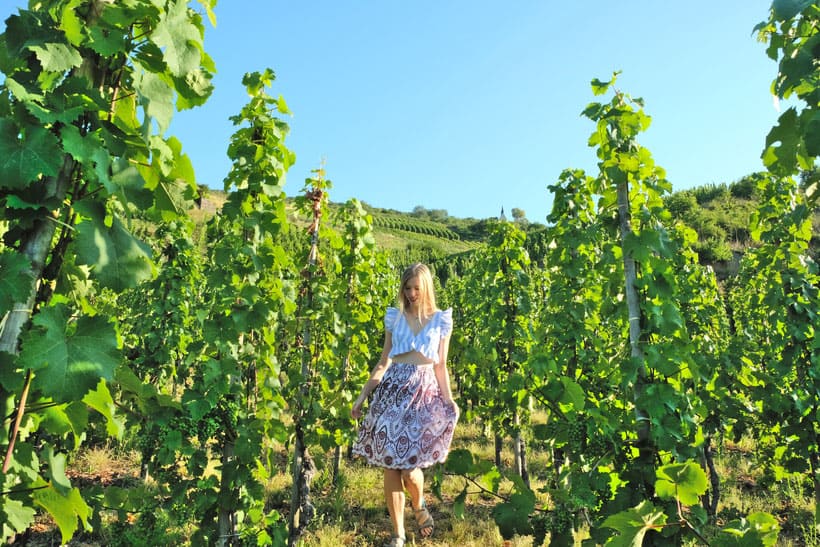
A fine wine tasting often goes hand in hand with visiting a vineyard in the Mosel valley. Many of them even run restaurants and have guest rooms. I truly recommend adding an overnight stay at a vineyard to your Mosel valley itinerary!
The best part of staying in a hotel of a winery is that you get a unique insight in the daily life of a vintner. And often, especially during warm summer nights, winemakers have the time to chat with their guests and give special Mosel river wine tours. It’s a fabulous way to immerse with the wine culture of the Mosel valley and to connect with locals.
Indeed vintners in the Mosel valley are very warm-hearted people and love to share their passion and knowledge for wine.

In some cases, they may even show you their cellars or join you on a walk through their vineyards. As said, it all depends on their schedule and how much you’re interested in the local viticulture.
A perfect example of a Mosel vineyard which works as a hotel is the Weingut Henerichs in Pommern. Sabine, vintner, former Weinkönigin (wine Queen) and manager of the guest house, is together with her partner Bernhard, the heart & soul of this place. A 3rd generation winemaker, Sabine is in charge of the fully renovated guest house and the restaurant. They serve delicious German, “vintner gastronomy” and the wine card including a selected range of the vineyard’s finest products is to die for.

It’s worth mentioning that Miss Henerichs is sticking to the traditional way of winemaking. That means that she refuses to add any additives to the wine in order to accelerate the fermenting process. Even though the process may take longer, the final quality of the wine is superior in the end. On top, by this method, even sweet wines will not give you stomach acids or headaches the day after.
If you want to stay in the Mosel area, the Weingut Henerichs is the ideal base for exploring the Mosel river valley and perfect to immerse with the local viticulture. In case you’re interested in full immersion with a culture, I recommend giving house-sitting in Europe a try.
Book here your stay at the Weingut Henerichs
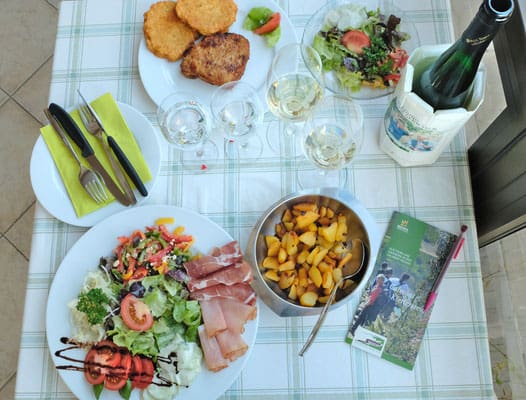
5. Explore Mosel Wine Villages

The wine villages next to the Mosel river bank seem to come straight from a fairytale setting. Sometimes you wonder if people even live in this romantic movie setting?
When you wander along the cobbled streets and tumbled houses (Fachwerk), it’s easy to imagine how life must have been hundreds of years ago. Indeed the Mosel valley wine villages managed to preserve their traditional charm and were not replaced by large concrete settlements.

The importance of viticulture is also reflected in the architecture and urban setting of each village. Wine and harvest scenes are painted on house fronts and vines are climbing along passages providing a perfect frame.
Photography lovers will especially enjoy a visit to Mosel’s wine villages as they provide many picturesque photo motives. Especially during the Golden Hour, you’ll enjoy the beauty of these quaint villages.
Some of the most popular villages along the Mosel valley river are:
- Traben Trarbach
- Bernkastel Kues
- Zell an der Mosel
- Enkirch

I also liked Pommern and Moselkern for their very quiet setting, away from the tourist crowds. Both villages are the perfect place to unwind while being surrounded by vineyards, timbered houses and close to the Mosel river bank.
I particularly recommend a visit of Treis-Karden whose major attractions are the impressive churches such as the Sain Castor’s Foundation Church, the Georgskapelle, a Gothic Evangelical church, and the Hochkreuzkapelle which enhance the beauty of this wine village.

6. Take a Mosel Valley River Cruise

For those who can’t decide which village is the quaintest (a very hard choice, indeed) and in which one they prefer to stay, I recommend taking a river cruise on the Mosel (often including the Rhine river as well).
Indeed it’s the perfect way to explore the beauty of the Mosel river, in a very laid-back way, making the most of your time.

First, you’d need to differ between the Mosel river cruises where you’re onboard for several days in a row with your private cabin or whether you prefer to take just a little excursion down the Mosel river.
If you decide to go for the first option, you’re on a boat for an average of 8 days during which the ships stop in the most emblematic sites along the Mosel river. It’s the perfect way to unwind and visit the beautiful Mosel river Valley without any stress and with a luxury note. If you can’t decide where to stay in the Mo
sel area, this is the perfect option.
READ: Highlights of a Rhine River Day Cruise
The fun option to enjoy a cruise on the Mosel river is by doing a day trip on a boat or just cruise from one wine village to another.
The main cruise company on the Moselle is the family-run Gebrüder Kolb, operating 14 vessels.
Book here the best Moselle, Germany river cruises
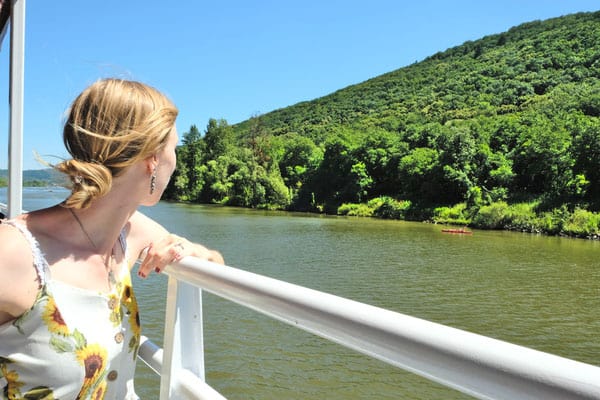
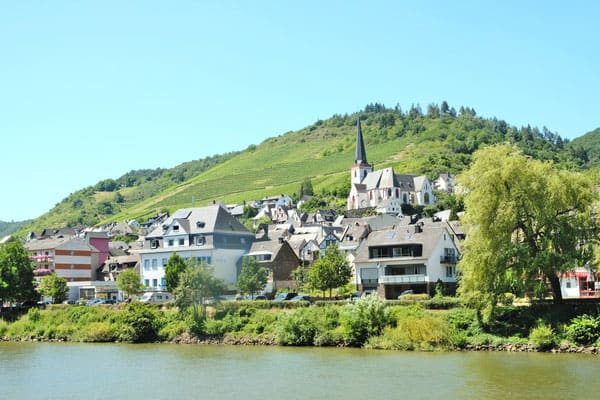
7. Visit Cochem

How to get to Cochem:
The easiest way is by train. Check Railway Prices here
***
A visit to the picturesque town of Cochem is a must when traveling to the Mosel river valley. Not only is it one of the most scenic locations on the Mosel river bank, but it’s also full of history.
The first thing that will probably catch your attention is the impressive castle “Schloss Reichsburg” towering above the town while pastel-colored houses along the river provide a fairytale-like setting. This Mosel castle was rebuilt in the 1870s on top of medieval ruins. A walk up to the castle is certainly rewarding and you can even visit the interior of the castle.

You can’t leave Cochem without strolling through its picturesque historic city center. The half-timbered, pastel-colored houses, topped with Mosel slate tiles and cobbled streets, Cochem has an undeniable charm to spend a lazy afternoon.
The Marktplatz (market place) with its Baroque town hall and the imposing entrance gates to the town are witnesses of Cochem’s eventful history.

I enjoyed having my meal next to the Enderttor, the Medieval city gate, away from the crowds. Indeed Cochem can be very busy on weekends. However, if you’re patient enough to find a remote terrace, you’ll have a memorable afternoon in Cochem while sipping one of its delicious Riesling wines.


8. Hike the Calmont Klettersteig Trail
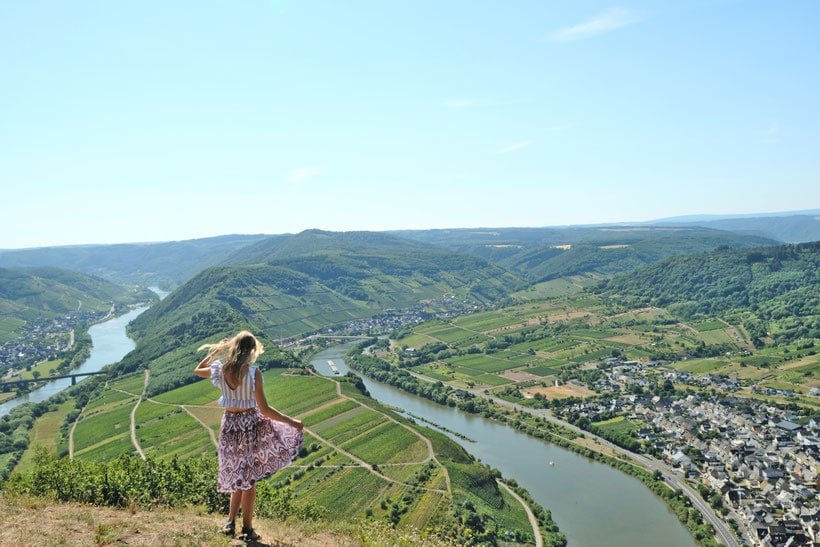
How to get to Calmont Klettersteig:
The easiest way is by train and start your hike from Ediger-Eller train station. Check Railway Prices here
***
Do you want to add a little adventurous feeling to your weekend in the Mosel river valley? Well, then I recommend that you hike the Calmont Klettersteig trail which brings you to the steepest vineyard in Europe. It’s part of the 16th leg of the Moselsteig Hiking Trail.
The trail departs from the train station Ediger-Eller and goes up to the Galgen-lay hut and the Amphitrion viewpoint. From here you follow the indications to Bremm and walk through the Calmont vineyard. Before reaching Bremm, you need to climb steeply some 300m to reach the summit cross.

From here you’ll have the most breathtaking views in the entire Mosel region of Germany. There is an easier way through the forest that brings you back to the train station of Ediger-Eller and passes along a Roman hill shrine.
I found it absolutely impressive to imagine that winegrowers have to make their way up that steep hill during the harvest season. All the work is still done manually.
Once you reach the summit cross, you should pamper yourself at the wine tavern on the summit which is managed by Weingut Michael Franzen. Get yourself a tangy Riesling wine and some home-made cake and enjoy the best views over the Mosel valley. The summit cross viewpoint is also a hotspot for para-gliders.
Do you want a special treat? What about breakfast at the 280m high summit cross? Every Saturday and Sunday, the Franzen family organizes a breakfast with regional products at the summit cross. Please reserve your spot beforehand at: www.calmontfruehstueck.de

The steepest parts of the trail are secured with ladders, steel cables, and iron stirrups. During these parts make sure to hold yourself strongly and postpone taking photos until you’re on the path again. Indeed, absolutely stunning vistas will catch your breath at several parts of the trail.
I would classify the Calmont Klettersteig as easy-moderate and recommend in the early morning or late afternoon because there is not much shade.
The name says it all: Calmont Klettersteig comes from the Latin calidus = “warm” and mons = “hill”, i.e. “warm hill”. Indeed the hill is directly exposed to the sun for many hours. On top the slate soil stores the heat. Some vintners told me that they feel like in an oven during the harvest or during summer days.


9. Visit Beautiful Mosel Castles

Are you like me and always looking for a special highlight or motivation during your hike? Well, in the Mosel River Valley, you’ll be spoilt with fairytale-like castles which can be easily reached by hiking.
Indeed is there something more rewarding than suddenly spotting a medieval fortress and approaching it slowly to enjoy it in all its beauty?
Besides the Mosel castles already mentioned in this article, Reichsburg in Cochem and Burg Eltz castle, a rich panoply of castles along the Mosel river are awaiting you.
Some of the most scenic Mosel castles, fortresses and medieval ruins are the following:
- the Grevenburg Castle ruins from the mid-1300s in Traben-Trabach
- Stolzenfels Castle, perched on lush green hills a few miles from Koblenz and dates back to the 13th century.
- Burg Landshut in Bernkastel-Kues
- Castle Ruin Winneburg in Cochem
- Ehrenburg in Brodenbach
- Schloss Zell in Zell an der Mosel
- Ruins of Burg Coraidelstein in Klotten
- Burg Thurant in Alken
River Cruises are often the ideal, stressless way to hop from one castle to another along the Mosel river.
READ: The Best European Christmas Market Cruises
Because there are numerous castles near Trier, Germany located throughout the Mosel region, Trier is a popular starting point to explore the Mosel river valley.

10. Explore Celtic & Roman Heritage in Trier and Mosel region

The region around Trier with its UNESCO World Heritage sites and the Mosel river valley was once settled by the Romans. Over 100 attractions are a testimony to their exceptional achievements and heritage in the region. If you love history, your Mosel valley itinerary will feel incomplete with out a visit to a few of the region’s archeological sites!
I truly recommend exploring some of the Roman historic sites along the Mosel river as their advanced achievements will leave you in awe.
Whereas Trier is the city with the most Roman heritage sites, there are several sites worth visiting in the Mosel river valley as well.
You could start your days in the Stiftsmuseum in Treis-Karden which gives you an overview of the Roman heritage in the Mosel valley. After your visit, I recommend climbing up the Martberg hill near Pommern which hosts a Roman and Celt shrine.
Not only will you enjoy beautiful views on the Mosel river but you’ll also get a deep insight into the spiritual beliefs of the Romans and Celts
As you continue your Roman exploration day, I recommend heading over to Cochem-Sehl where you’ll visit Roman tombs in the forest of Nehren. Indeed the tomb paintings are some of the best-preserved in Europe.
If you hiked the Calmont Klettersteig you certainly came across the Gallo-Roman mountain sanctuary which was only discovered in 2005.
How to get to Martberg in Pommern:
The easiest way is by train and start hiking from Pommern train station. Check Railway Prices here
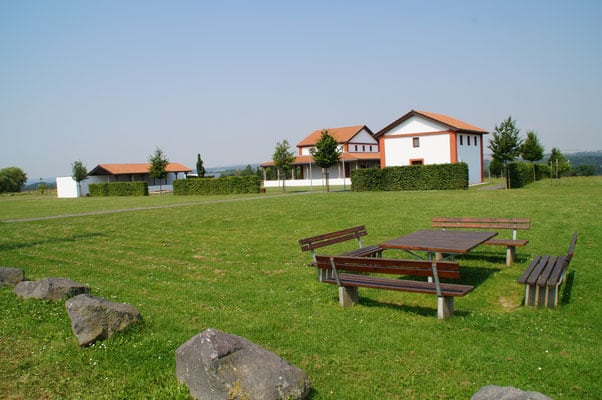
11. Explore Beautiful Cities on the Moselle River, Germany

One of the benefits to there being so many beautiful castles along the Moselle is that they come with equally captivating cities.
Pont-à-Mousson, Schengen, Koblenz – and of course Cochem – all offer their own unique charms and hospitalities to visitors. The individual histories of these settlements is also rich and diverse.
Once you’ve had your fill of Mosel wine tastings and tours, places such as Trier can offer insight into their Celtic and Roman history, and picturesque Remich contains Norman fortifications from the 10th century that are still visible today. If you love castles, I recommend starting here, as there are so many Mosel castles near Trier, Germany.
For more recent history, the Mosel also runs through the town of Schengen, where the still active Schengen Agreement was signed in 1985, enabling free travel between participating European member states.
I hope some of these, admittedly very personal, highlights of my visit to the Mosel River Valley in Germany convince you to include the beautiful north in your travel plans. Touring the Mosel valley in Germany is a trip you’ll never forget!
Have you been in the Mosel Valley, Germany? Did you enjoy it? I would love to hear about the things you loved (or loved less) in the comment form.
Map: Highlights of Moselle Valley, Germany
Before You Go: Top Tips for your Trip
- You’ll be snapping tons of photos during your trip. Rather than relying on your mobile phone to capture the sights, upgrade to an actual camera for higher quality photos. I travel with a FUJI XT2 (mirrorless, takes amazing photos) and Action Camera GoPro HERO5 Session (takes beautiful photos in the most extreme situations, slim & lightweight). All of the cameras are WiFi-enabled so you can share your trip pics to social media in real-time!
- When spending a lot of time on the road, I love to wear my trekking sandals.
- Travel insurance is essential! If you haven’t already obtained travel insurance for your trip, travel protected against all odds with SafetyWing
***
In order to get more information on tourism in Mosel Valley, Germany, I recommend the site of Moselland Touristik
Short FAQ
How to get from Frankfurt to Mosel Valley?
The quickest and easiest way to get from Frankfurt to Mosel Valley is by train via Koblenz. You can also get the bus, which takes longer but is cheaper.
Where is the Mosel River?
The Mosel river flows through France, Luxembourg and Rhineland-Palatinate, Germany. The German part of the Mosel river valley stretches from Perl to Koblenz where it flows into the Rhine.
What is the best German Riesling?
This is definitely down to personal taste, but many of the best white German Rieslings can be found in the vineyards along the Mosel river valley!
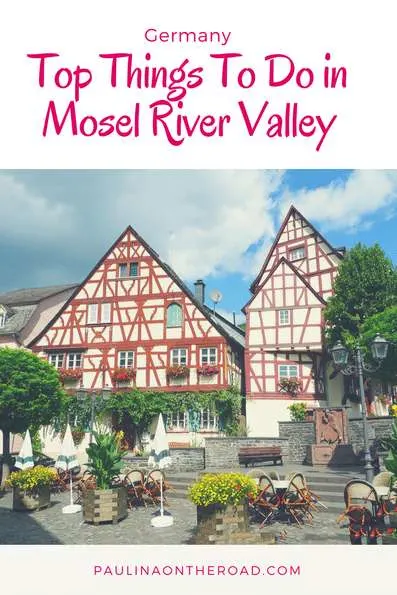


Hola! I’m Paulina, a seasoned travelette who crossed the Atlantic Ocean by Boat HitchHiking. On my blog, find expert insights for an extraordinary holiday through outdoor and sustainable travel like hiking, cycling, and sailing. Let’s embark on unforgettable journeys together! 🌍🚀



